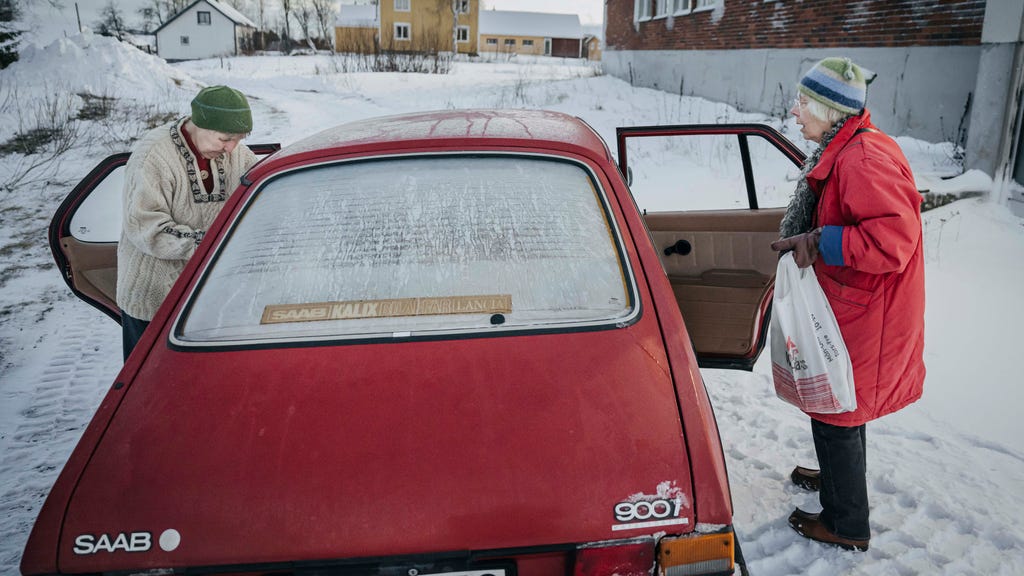The December darkness had descended upon Korpilombolo, a small village nestled in the Tornedalen region of northern Sweden. Inside the local cultural center, a soft glow illuminated the hushed anticipation of the gathered crowd, awaiting the final act of the annual Nattfestivalen (Night Festival). A procession of Lucia singers, their hands cradling flickering candles and hair adorned with shimmering silver, glided through the room, their voices weaving the haunting melody of ”Natten går tunga fjät” (Night Walks with Heavy Footsteps), a classic Swedish Lucia song. Among them, 77-year-old Märta Nylund, one of the festival’s organizers, walked gracefully in a white cape, a serene figure amidst the ethereal spectacle. As the Lucia train, a poignant symbol of returning light, exited the hall, Märta’s sister and fellow organizer, 74-year-old Linnea Nylund, approached the makeshift stage. With a mix of gratitude and melancholy, she thanked the participants and attendees, reflecting on the festival’s almost dreamlike quality. Her voice then took a somber turn as she acknowledged the absence of loved ones, particularly their sister Karin, who had recently passed away.
The Nylund sisters, Märta and Linnea, were the heart and soul of Nattfestivalen. A few days prior to the festival’s opening, over a shared plate of chicken kebab and glasses of milk in the cultural center’s restaurant, they recounted the festival’s genesis. Twenty years earlier, Linnea had been approached to organize a festival, a task she accepted with naive enthusiasm, unaware of the magnitude of the undertaking. The festival’s origins lay with Julian Vasquez, a Colombian captivated by Korpilombolo after encountering the village in the works of author León de Greiff. Vasquez’s subsequent visit in 2004 sparked the idea of a festival celebrating the night, appropriately scheduled during the darkest period of the year, from December 1st to 13th. Over two decades, the festival transformed the quiet village of 500 into a vibrant hub of cultural exchange, drawing artists, musicians, and performers from 43 countries to explore the multifaceted nature of night through poetry, music, philosophy, and art. For the sisters, the festival was a means of revitalizing their community while highlighting issues they were passionate about, such as cultural diversity and environmental awareness, interwoven with their own Tornedalian heritage.
The journey, however, was not without its challenges. Lacking prior experience in event organization, the sisters, all former teachers, navigated the complexities of festival planning with determination and a spirit of improvisation. They embraced the creative potential of the night, viewing it as a time for reflection and the gestation of new ideas. The festival’s 20th anniversary was particularly poignant, marked by both celebration and loss. The theme of diversity and environment resonated deeply in the current global context, providing a platform for dialogue and artistic expression. Workshops, author talks, and performances, including a concert by Tibetan singer Loten Namling, filled the festival program. But amidst the vibrant activities, the sisters carried the weight of Karin’s absence. Her passion for writing and theatre, nurtured through the festival, served as a source of inspiration and motivation.
The sisters’ lives were deeply intertwined with their Tornedalian heritage and the echoes of their family history. Their childhood home, a red-painted haven in the nearby village of Markusvinsa, bore witness to their shared memories and the传承 of their mother tongue, Meänkieli. Linnea recalled their father’s experience in a ”work cottage,” institutions established in early 20th-century northern Sweden as part of a forced assimilation policy aimed at suppressing minority languages and cultures. While acknowledging the painful memories associated with these institutions, Linnea also recognized the skills her father acquired there, including handicrafts. The legacy of their parents, one expressed through storytelling and culinary traditions, the other through the artistry of his hands, instilled in the sisters a deep appreciation for craftsmanship and cultural preservation.
This love for craft was evident in their home, adorned with handmade decorations and self-painted canvases. The spirit of resourcefulness and creativity, inherited from their parents, manifested in Linnea’s repurposing of her mother’s old boot shafts into a unique handbag, its wooden handles whittled by her own hands. This resourceful spirit, coupled with their passion for their community and cultural heritage, fueled their commitment to the festival. The loss of Karin, described by Linnea as removing a leg from a tripod, left a void in their lives and in the festival’s organizational framework. Yet, they persevered, honoring Karin’s memory and her unwavering belief in the festival’s importance.
In the aftermath of the festival, as Linnea and Märta rested in their home, a sense of quiet contemplation settled over them. Despite the challenges and emotional toll, the sisters found solace in the knowledge that they had carried on Karin’s legacy and brought the community together through the celebration of art and culture. The future of the festival remained uncertain, with financial constraints and the weight of their loss posing significant hurdles. Yet, a spark of hope glimmered in their eyes as they discussed potential future projects, envisioning a festival that would unite the indigenous and minority groups of the region – the Sami, Tornedalians, Kvens, and Forest Finns – through the power of storytelling. Their unwavering curiosity and dedication to their cultural heritage hinted at the enduring spirit of Nattfestivalen, a testament to the transformative power of art, community, and the resilience of the human spirit.
As they rested, Linnea on the kitchen sofa and Märta on the floor, covered by blankets, they exemplified the quiet fortitude that had sustained them through two decades of festival organization. Their shared vision extended beyond the immediate future, encompassing a desire to foster connections and understanding between different cultural groups. The floor, Märta remarked, offered a grounding comfort, a fitting metaphor for their rootedness in their community and their commitment to preserving its cultural richness. The conclusion of the 20th Nattfestivalen marked not an ending, but a pause, a moment of reflection before embarking on the next chapter of their cultural journey.














